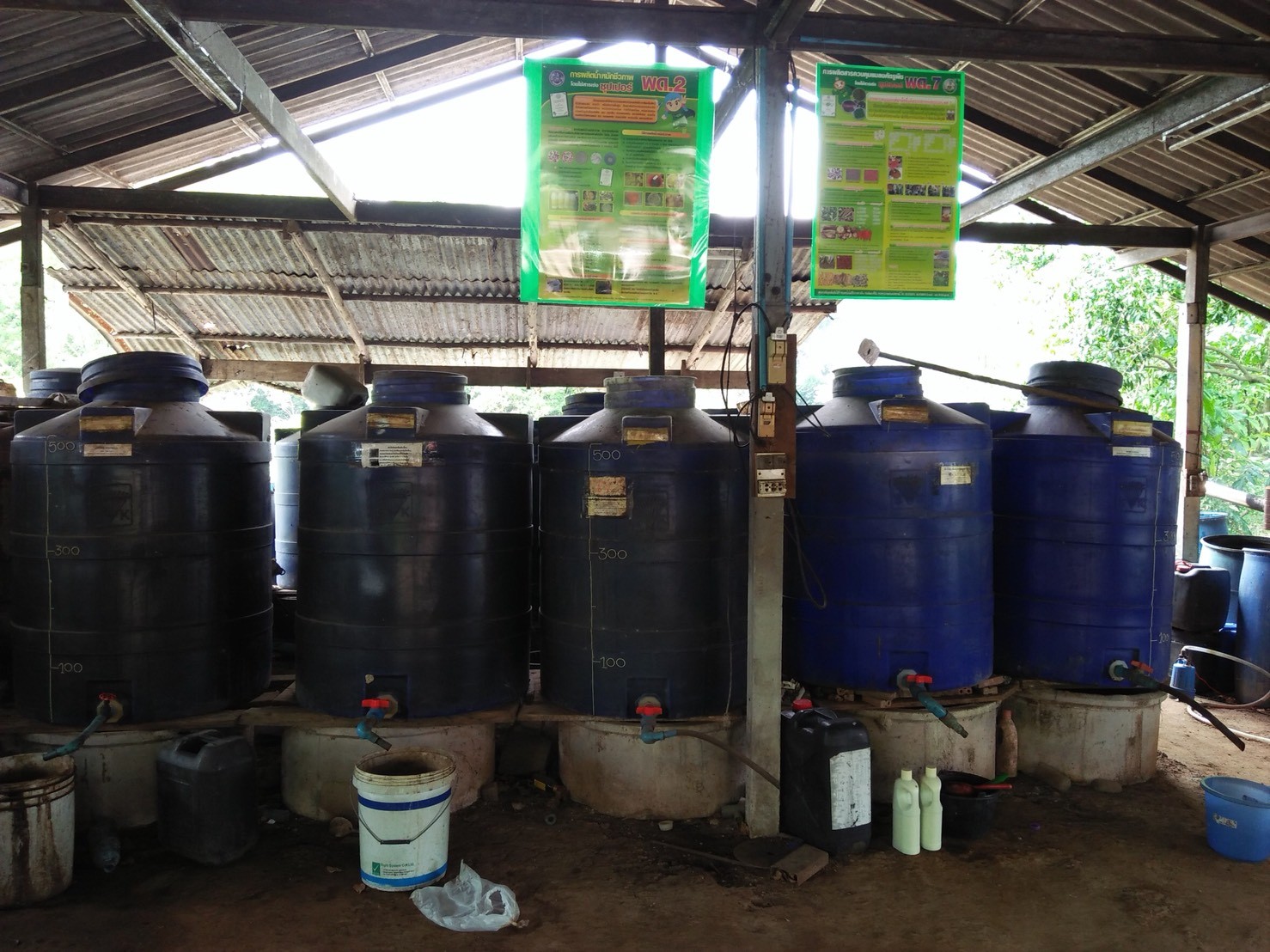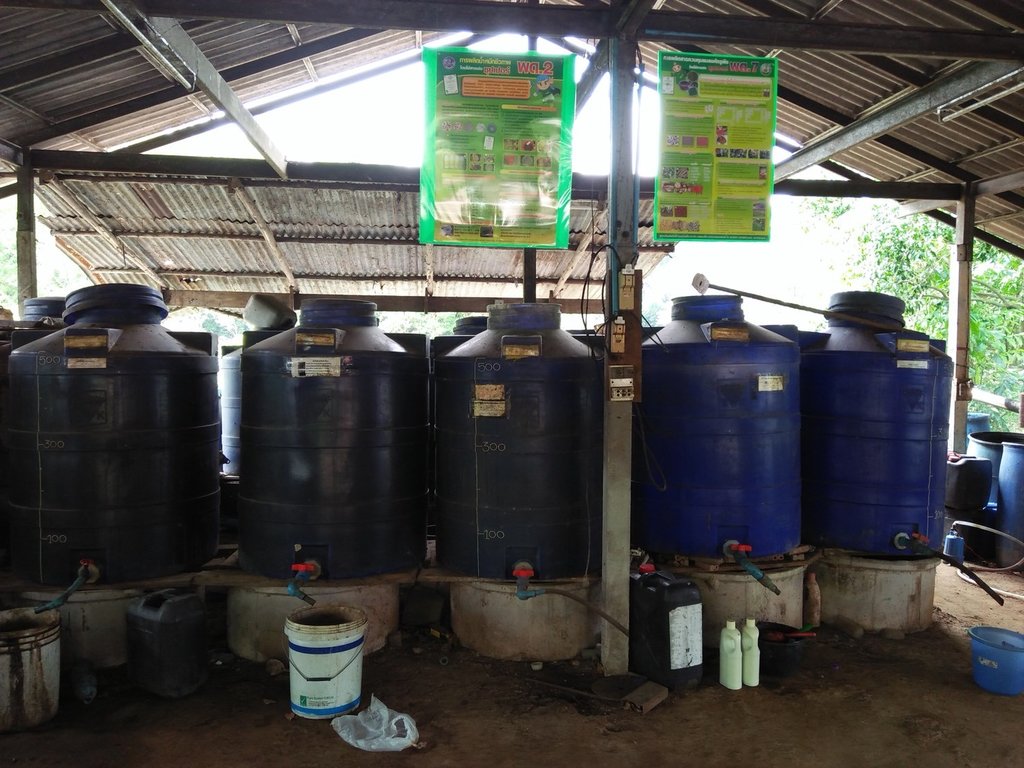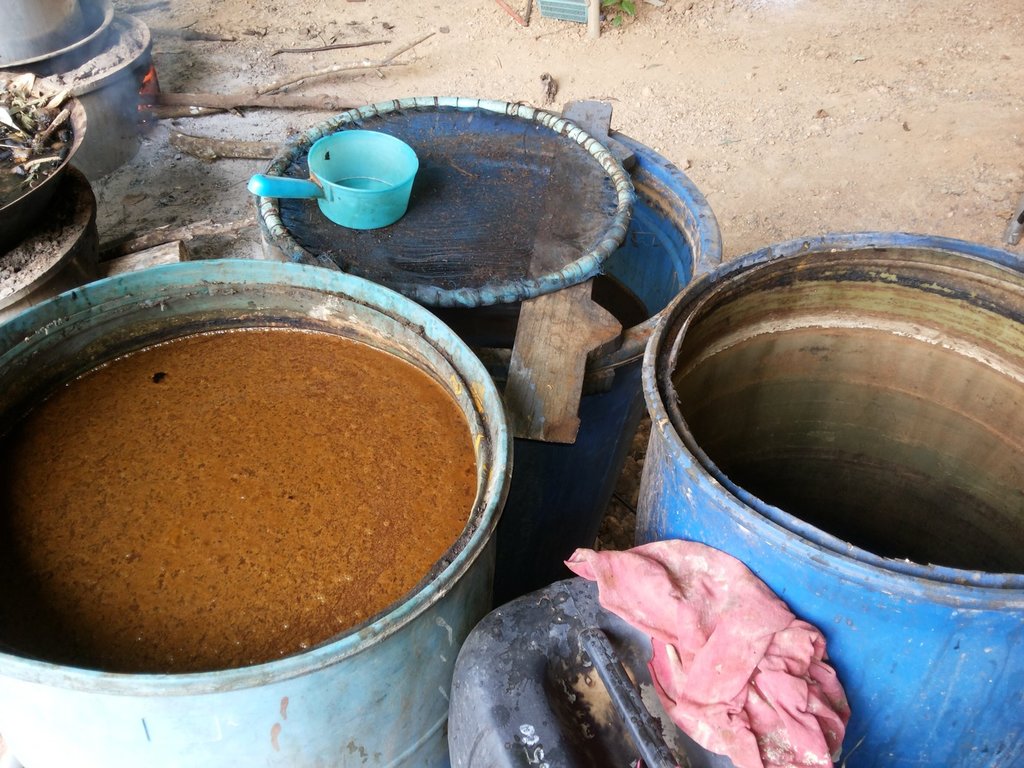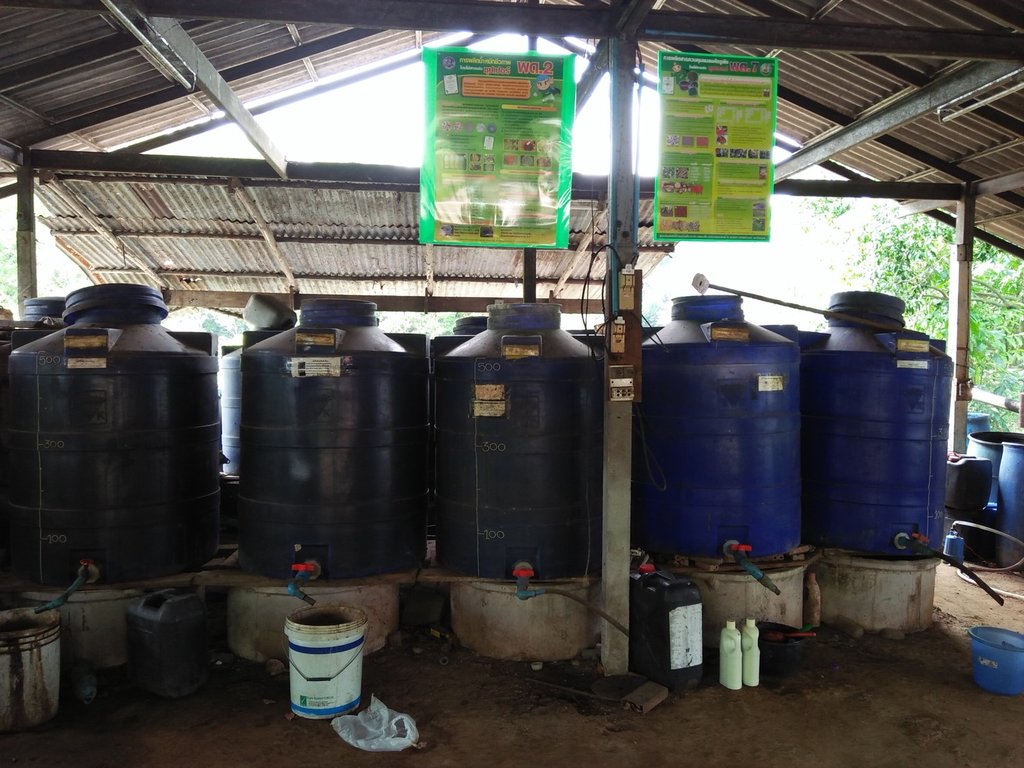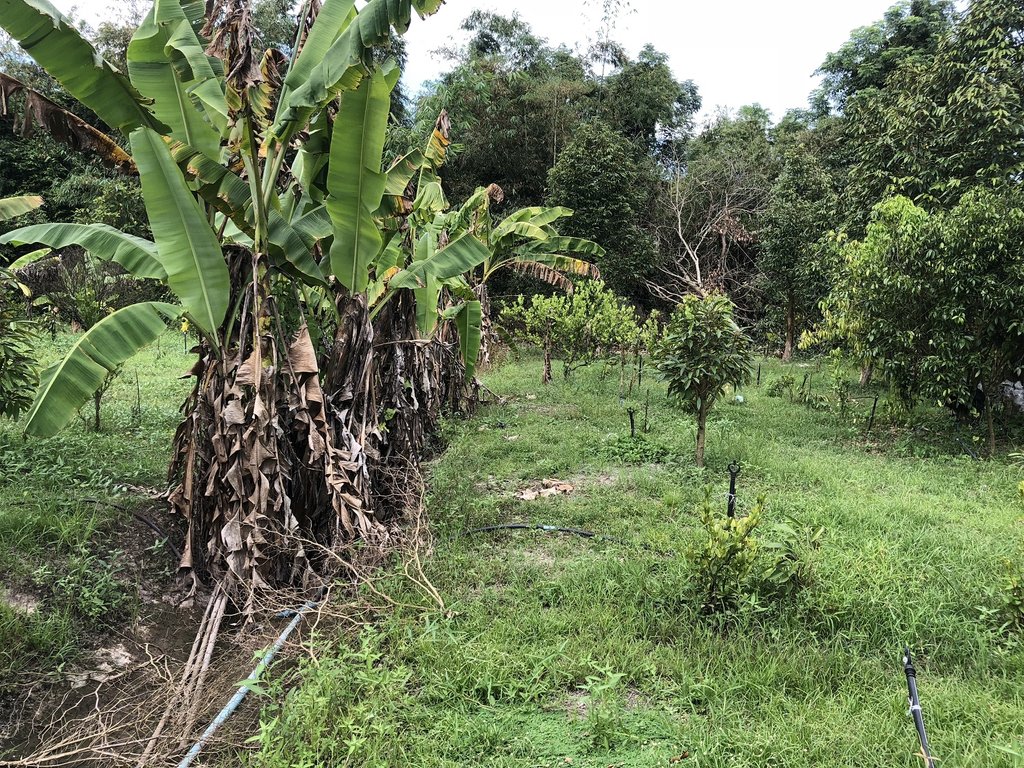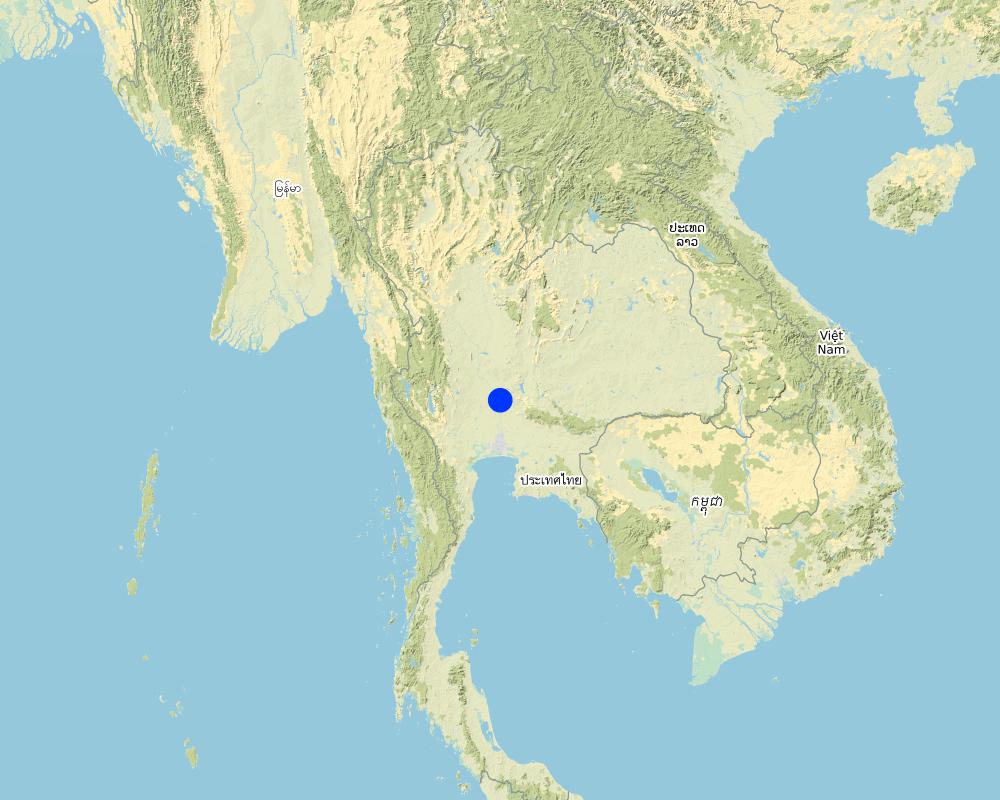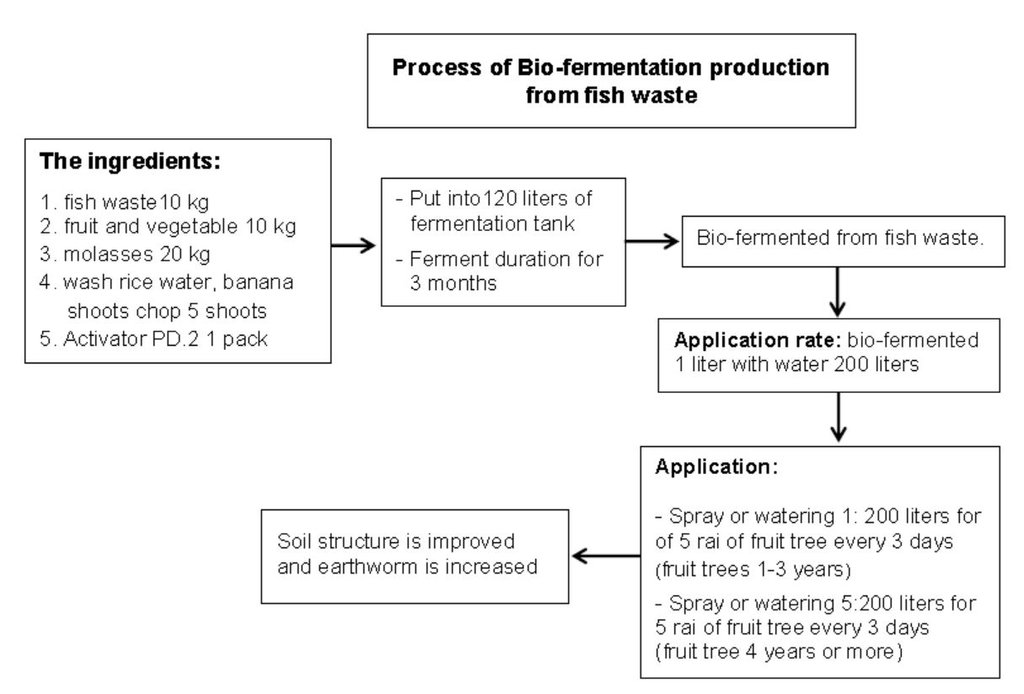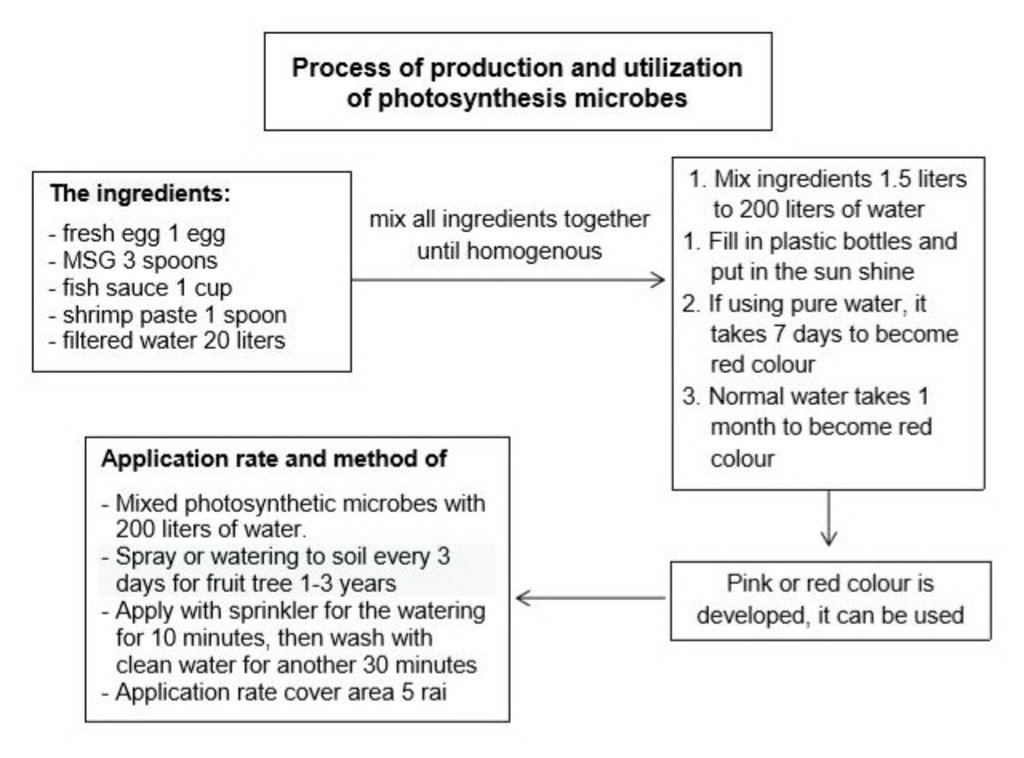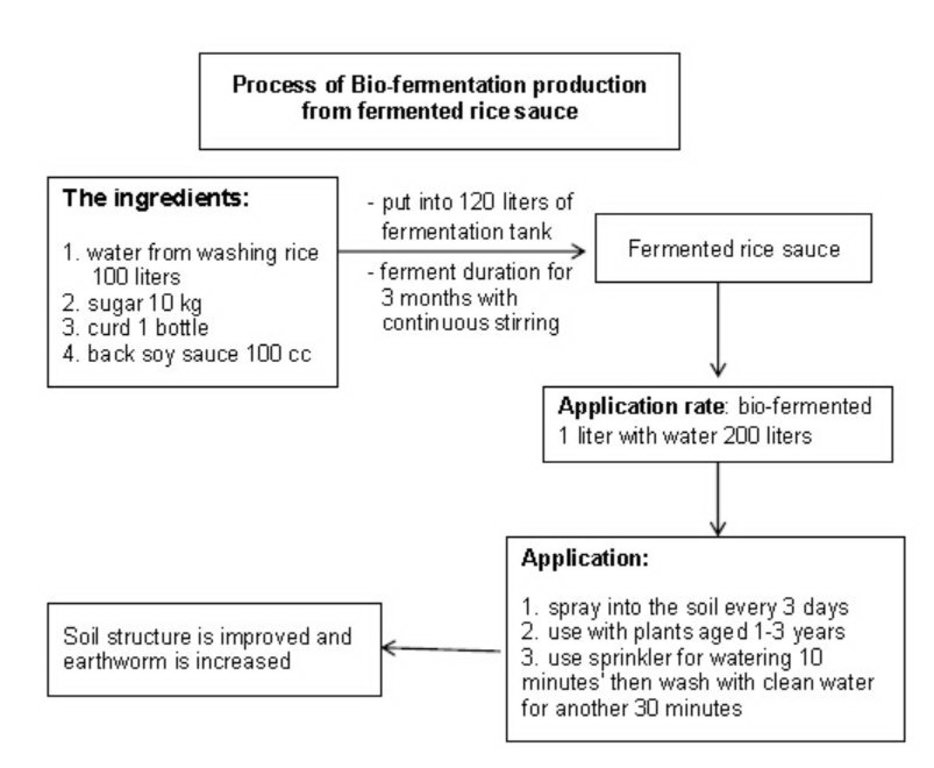Bio-fermentation technology for soil improvement
- تاريخ الإنشاء:
- تحديث:
- جامع المعلومات: Kukiat SOITONG
- المحرر: –
- المراجعون: Rima Mekdaschi Studer, William Critchley
Num Mak She Wa Parp
technologies_4233
عرض الأقسام
توسيع الكل طي الكل1. معلومات عامة
1.2 تفاصيل الاتصال بالأشخاص الرئيسيين لمصدر المعلومات والمؤسسات المشاركة في تقييم وتوثيق التقنية
الشخص (الأشخاص) الرئيسي لمصدر المعلومات
متخصص في الإدارة المستدامة للأراضي:
ผู้รวบรวม:
ดุรงค์กาญจน์ นายสาโรช
สถานีพัฒนาที่ดินปราจีนบุรี สำนักงานพัฒนาที่ดินเขต 2 กรมพัฒนาที่ดิน
تايلاند
مستخدم الأرض:
สนลอย นางวันเพ็ญ
เกษตรกร และหมอดินอาสาประจำจังหวัดปราจีนบุรี กรมพัฒนาที่ดิน
تايلاند
متخصص في الإدارة المستدامة للأراضي:
สนลอย นางวันเพ็ญ
เกษตรกร และหมอดินอาสาประจำจังหวัดปราจีนบุรี กรมพัฒนาที่ดิน
تايلاند
متخصص في الإدارة المستدامة للأراضي:
สนลอย นางวันเพ็ญ
เกษตรกร และหมอดินอาสาประจำจังหวัดปราจีนบุรี กรมพัฒนาที่ดิน
تايلاند
1.3 الشروط المتعلقة باستخدام البيانات الموثقة من خلال WOCAT
يوافق جامع المعلومات والشخص (لاشخاص) الرئيسي لمصدر المعلومات على الشروط المتعلقة باستخدام البيانات الموثقة من خلال WOCAT:
نعم
1.4 إعلان بشأن استدامة التقنية الموصوفة
هل التقنية الموصوفة هنا تمثل مشكلة فيما يتعلق بتدهور الأراضي، بحيث لا يمكن إعلانها تقنية مستدامة لإدارة الأراضي؟:
كلا
التعليقات:
การใช้เทคโนโลยีชีวภาพในพื้นที่ดินค่อนข้างเป็นทราย เสื่อมโทรม ช่วยปรับปรุงโครงสร้างดิน เพิ่มจุลินทรีย์ในดิน ทำให้ดินร่วนซุย ช่วยลดการใช้สารเคมี และช่วยรักษาสิ่งแวดล้อม
2. وصف تقنيةالإدارة المستدامي للأراضي
2.1 وصف مختصر للتقنية
تعريف التقنية:
Bio-fermentation technology for soil improvement is an alternative technology that helps to restore degraded land from intensive land usage which lack of soil improvement to get back to be the soil productivity that can provide effective production.
2.2 وصف تفصيلي للتقنية
الوصف:
The area has chemical and physical degradation problems. The area is the lowland. The soil is quite sandy. The soil structure is poor which the draining system is quite bad. The organic matter, soil nutrients and soil fertility is low.
Farmers use the land to grow rice but have the low rice yield. Farmers have changed their rice fields to grow their crops instead.
Which changing the area from the normal rice field by digging the ditch for 1 meter wide on growing area, 1 meter wide for the drain and 0.80 meters deep)that grow durian, banana, lime, vegetable (Climbing Wattle)
The weed management by using chemicals and chemical fertilizers in the high rate continuously to make the soil degrade or dense and grow the ineffective crops.
Bio-fermentation technology for soil improvement consists of the production of 3 types of biological fermentation and the usage of 3 types of biological fermentation as follows:
1. Product Processions of bio-fermented water
The methods of the 3 types bio-fermented producing are as follows.
1.1 Production of bio-fermented from the fish fraction by using the Microbial Activators from LDD.
1.2. Production of photosynthetic microorganisms
1.3 Production of Bio-Fermented Water from rice flour water
2. How to use the bio-fermentation to improve the soil
Mix the three bio-nutrients at a rate of 1: 1: 1 per 200 litters of water and spray or pour on the ground every 3 days or use sprinkler system by releasing the bio-fermented water mix with water for 10 minutes followed and wash it with water for 3 minutes for 3 years (at the beginning of the growing season).
The usage of Bio-fermentation technology to improve the soil has the objective is to restore the degradation of agricultural land for a long term and using the high rate of chemical fertilizers continuously to be able to do the farm effectively.
The usage of Bio-fermentation technology to improve the soil has the important activities to do are following:
1. Product Processions of Bio-fermentation Solution
The methods of the 3 types bio-fermented producing are as follows.
1.1 Production of bio-fermented from the fish fraction by using the Microbial Activators PD2 by using the fish fraction about 10 kilograms, the fruit and vegetable fraction about 10 kilograms, molasses about 20 kilograms, the rice flour water or the banana fraction about 5 spire and the Microbial Activators PD 1 packet to mix everything in the tank size 120 litters for 3 months.
1.2. Production of photosynthetic microorganisms made by 5 eggs, 3 tablespoons of MSG, 1 tablespoon of fish sauce, 1 tablespoon of filtered water and 20 liters of pure water mixed in a homogeneous mixture at the rate of 1.5 liters per 200 liters of water for 7 days and it will be red (in case of using the pure water) and 1 month (in case of using clear water).
1.3 Production of bio-fermented solution from using 100 liter of rice flour water, 10 kilogram of sugar, 1 yakult bottle (curd) and 10 milliliters of fermented soy sauce in a 120 liters pot size fermentation tank for 3 months
2. The using steps of bio-fermented solution to improve the soil to improve the soil in the crop land for the different periods of cultivation as follows.
2.1. The early stage before the production period (1-3 years)
Mix the three types ofBio-fermentation solution at a rate of 1: 1: 1 per 200 litters of water and spray or pour on the ground every 3 days or use sprinkler system to release the bio-fermented water for 10 minutes and use the clear water later for 30 minutes
2.2 The yield period (more than 4 years)
To dissolve the bio-fermented which from the fish for 5 liters: 200 liters of water and spray or pour on the ground every 3 days or use sprinkler system to release the bio-fermented water for 10 minutes, followed by 30 minutes of the clear water.
1. Make the soil more fertile, organic matter and microorganisms in soil (earthworm). The benefits of nutrients in the soil increase. It can grow durian which can be sold at high prices (180 baht / tree).
2. Reduce the plant production costs due to using the waste materials from the land to be the fermentation materials. The farmers have increased income, lives are not dependent on themselves and the using the biotechnology does not have an impact on the environment.
1. This technology is the knowledge that is derived from experiential / practical experiments in the area of farmer prototype technology users which can see the real results from using it.
2. The methods / procedures are not complicated.
3. It is easy to use, not difficult mosquitoes.
4. There are multichannel technology has been released that the farmers can access it easily.
1. This technology (bio-fermentation / bio-extract) does not have any nutritional status checking which cannot be shown the quantity.
2. Farmers generally lack of the motivation to do and use.
2.3 صور التقنية
2.4 فيديوهات عن التقنية
تعليقات، وصف موجز:
การใช้เทคโนโลยีชีวภาพเพื่อการพัฒนาที่ดิน
التاريخ:
07/03/2018
اسم مصور الفيديو:
กรมพัฒนาที่ดิน
2.5 البلد/المنطقة/المواقع التي تم تنفيذ التقنية فيها والتي يغطيها هذا التقييم
المنطقة/الولاية/المحافظة:
ภาคตะวันออก/จังหวัดปราจีนบุรี
مزيد من التفاصيل حول الموقع:
62/1 หมู่ 5 ตำบลไม้เค็ด อำเภอเมือง จังหวัดปราจีนบุรี
Map
×2.6 تاريخ التنفيذ
اذكر سنة التنفيذ:
1997
في حالة عدم معرفة السنة بالتحديد، يرجى الإشارة إلى التاريخ التقريبي:
- منذ 10-50 سنة
2.7 إدخال التقنية
حدد كيف تم إدخال التقنية:
- من خلال ابتكار مستخدمي الأراضي
3. تصنيف تقنية الإدارة المستدامي للأراضي
3.1 الغرض الرئيسي ( الأغراض الرئيسية) للتقنية
- تحسين الإنتاج
- الحد من تدهور الأراضي ومنعه وعكسه
- الحفاظ على النظام البيئي
- الحفاظ على/تحسين التنوع البيولوجي
3.2 نوع (أنواع) استخدام الأراضي الحالية حيث يتم تطبيق التقنية

الأراضي الزراعية
- زراعة الأشجار والشجيرات
- การปลูกพืชผสมผสาน
عدد مواسم الزراعة في السنة:
- 2
حدد:
-
التعليقات:
-
3.3 هل تغير استخدام الأراضي نتيجة لتنفيذ التقنية؟
التعليقات:
-
3.4 إمدادات المياه
إمدادات المياه للأرض التي يتم تنفيذ التقنية عليها:
- بعلية
التعليقات:
-
3.5 مجموعةالإدارة المستدامة للأراضي التي تنتمي إليها هذه التقنية
- الإدارة المتكاملة لخصوبة التربة
- الإدارة المتكاملة للآفات والأمراض (بما في ذلك الزراعة العضوية)
3.6 التدابير التقنية في مجال إلادارة المستدامة للأراضي

تدابير أخرى
حدد:
others การผลิตและการใช้น้ำหมักชีวภาพ
التعليقات:
มีการทำเกษตรแบบผสมผสานทั้งไม้ผลและพืชผักสวนครัว
3.7 الأنواع الرئيسية من تدهور الأراضي التي تناولتها التقنية

التدهور الكيميائي للتربة
- (Cn): تراجع الخصوبة وانخفاض محتوى المادة العضوية (غير ناتج عن الانجراف)

التدهور المادي أو الفيزيائي للتربة
- (Pc) : تراص التربة

التدهور البيولوجي
- (Bl): فقدان الحياة بالتربة
التعليقات:
เกิดจากการใช้ปุ๋ยเคมีมากเกินความจำเป็น เกินความต้องการของพืชต่อเนื่อง เป็นระยะเวลานาน ทำให้ดินเสื่อมโทรม
3.8 منع أو حد أو عكس تدهور الأراضي
تحديد هدف التقنية فيما يتعلق بتدهور الأراضي:
- الحد من تدهور الأراضي
- اصلاح/إعادة تأهيل الأراضي المتدهورة بشدة
التعليقات:
การใช้ปุ๋ยเคมีต่อเนื่องเป็นระยะเวลานาน ทำให้สมบัติทางเคมีและชีวภาพของดิน เสื่อมโทรมลง จำเป็นต้องได้รับการฟื้นฟู
4. المواصفات الفنية، وأنشطة التنفيذ، والمدخلات، والتكاليف
4.1 الرسم الفني للتقنية
المواصفات الفنية (المتعلقة بالرسم الفني):
1.กระบวนการผลิต น้ำหมักชีวภาพ
วิธีการผลิตน้ำหมักชีวภาพ 3 สูตร มีดังนี้
1.1 การผลิตน้ำหมักชีวภาพจากเศษปลาด้วยสารเร่ง พด 2 ผลิตโดยใช้ เศษปลา 10 กก. เศษผัก/ผลไม้ 10 กก. กากน้ำตาล 20 กก. น้ำซาวข้าว/หน่อกล้วยสับ 5 หน่อ และสารเร่ง พด.2 1 ซอง หมักในถังหมักขนาด 120 ลิตร นาน 3 เดือน
2. วิธีการใช้น้ำหมักชีวภาพเพื่อปรับปรุงบำรุงดิน
ให้นำน้ำหมักชีวภาพทั้งสามสูตรผสมกันในอัตรา1:1:1 ต่อน้ำ200 ลิตร ฉีดพ่นหรือรดลงดินทุกๆ 3 วัน หรือใช้ระบบสปริงเกอร์ โดยปล่อยน้ำหมักชีวภาพไปกับน้ำ 10 นาที ตามด้วยการล้างด้วยน้ำเปล่าอีก 30 นาที เป็นเวลา 3 ปี (ช่วงเริ่มต้นของการปลูกปลูกไม้ผล
المؤلف:
นายสาโรช ดุรงค์กาญจน์
التاريخ:
02/10/2018
المواصفات الفنية (المتعلقة بالرسم الفني):
1.2.การผลิตจุลินทรีย์สังเคราะห์แสง ผลิตโดยใช้ส่วนผลมไข่ไก่ ผงชูรส 3 ช้อนโต๊ะ น้ำปลา 1 แก้ว กะปิ 1 ช้อนโต๊ะ และน้ำกรองสะอาด 20 ลิตร ผสมจนเป็นเนื้อเดียวกัน ผสมนำในอัตรา 1.5 ลิตร ต่อน้ำ 200 ลิตร กรอกใส่ขวดพลาสติกใส วางตากแดด ใช้เวลา 7 วัน จะเกิดสีแดง (ในกรณีที่ใช้น้ำบริสุทธิ์) และใช้เวลา 1 เดือน (ในกรณีใช้น้ำประปาทั่วไป)
2. วิธีการใช้น้ำหมักชีวภาพเพื่อปรับปรุงบำรุงดิน
ให้นำน้ำหมักชีวภาพทั้งสามสูตรผสมกันในอัตรา1:1:1 ต่อน้ำ200 ลิตร ฉีดพ่นหรือรดลงดินทุกๆ 3 วัน หรือใช้ระบบสปริงเกอร์ โดยปล่อยน้ำหมักชีวภาพไปกับน้ำ 10 นาที ตามด้วยการล้างด้วยน้ำเปล่าอีก 30 นาที เป็นเวลา 3 ปี (ช่วงเริ่มต้นของการปลูกปลูกไม้ผล
المؤلف:
นายสาโรช ดุรงค์กาญจน์
التاريخ:
02/10/2018
المواصفات الفنية (المتعلقة بالرسم الفني):
1.3 การผลิตน้ำหมักชีวภาพจาก น้ำซาวข้าว ผลิตโดยใช้ น้ำซาวข้าว 100 ลิตร น้ำตาลทราย 10 กก. ยาคูลท์ 1 ขวด และซีอิ๊วดำ 10 มล. หมักในถังหมักขนาด 120 ลิตร นาน 3 เดือน
2. วิธีการใช้น้ำหมักชีวภาพเพื่อปรับปรุงบำรุงดิน
ให้นำน้ำหมักชีวภาพทั้งสามสูตรผสมกันในอัตรา1:1:1 ต่อน้ำ200 ลิตร ฉีดพ่นหรือรดลงดินทุกๆ 3 วัน หรือใช้ระบบสปริงเกอร์ โดยปล่อยน้ำหมักชีวภาพไปกับน้ำ 10 นาที ตามด้วยการล้างด้วยน้ำเปล่าอีก 30 นาที เป็นเวลา 3 ปี (ช่วงเริ่มต้นของการปลูกปลูกไม้ผล
المؤلف:
นายสาโรช ดุรงค์กาญจน์
التاريخ:
02/10/2018
المواصفات الفنية (المتعلقة بالرسم الفني):
1.3 การผลิตน้ำหมักชีวภาพจาก น้ำซาวข้าว ผลิตโดยใช้ น้ำซาวข้าว 100 ลิตร น้ำตาลทราย 10 กก. ยาคูลท์ 1 ขวด และซีอิ๊วดำ 10 มล. หมักในถังหมักขนาด 120 ลิตร นาน 3 เดือน
2. วิธีการใช้น้ำหมักชีวภาพเพื่อปรับปรุงบำรุงดิน
ให้นำน้ำหมักชีวภาพทั้งสามสูตรผสมกันในอัตรา1:1:1 ต่อน้ำ200 ลิตร ฉีดพ่นหรือรดลงดินทุกๆ 3 วัน หรือใช้ระบบสปริงเกอร์ โดยปล่อยน้ำหมักชีวภาพไปกับน้ำ 10 นาที ตามด้วยการล้างด้วยน้ำเปล่าอีก 30 นาที เป็นเวลา 3 ปี (ช่วงเริ่มต้นของการปลูกปลูกไม้ผล
المؤلف:
นายสาโรช ดุรงค์กาญจน์
4.2 معلومات عامة بخصوص حساب المدخلات والتكاليف
حدد كيفية احتساب التكاليف والمدخلات:
- حسب مساحة تنفيذ التقنية
الإشارة إلى حجم ووحدة المساحة:
1 ไร่
في حالة استخدام وحدة مساحة محلية، قم بالإشارة إلى عامل التحويل إلى هكتار واحد (على سبيل المثال، 1 هكتار = 2.47 فدان): 1 هكتار =:
-
عملة أخرى/ عملة وطنية (حدد):
Thai Baht
إذا كان ذا صلة، وضح سعر الصرف من الدولار الأمريكي إلى العملة المحلية (على سبيل المثال، 1 دولار أمريكي = 79.9 ريال برازيلي): 1 دولار أمريكي =:
32,0
اذكر متوسط تكلفة أجر العمالة المستأجرة في اليوم الواحد:
แรงงานต่อวันคือ 300 บาท
4.3 أنشطة التأسيس
| النشاط | التوقيت (الموسم) | |
|---|---|---|
| 1. | กระบวนการผลิตน้ำหมักชีวภาพ | - |
| 2. | วิธีการใช้น้ำหมักชีวภาพ | - |
التعليقات:
เป็นการใช้เทคโนโลยีระหว่างการบำรุงและดูแลไม้ผลก่อนเก็บเกี่ยวผลผลิต
4.4 التكاليف والمدخلات اللازمة للتأسيس
| تحديد المدخلات | الوحدة | الكمية | التكاليف لكل وحدة | إجمالي التكاليف لكل مدخل | % من التكاليف التي يتحملها مستخدمو الأراضي | |
|---|---|---|---|---|---|---|
| العمالة | จ้างผลิตน้ำหมักชีวภาพพด.2,จุลินทรีย์สังเคราะห์แสงน้ำหมักชีวภาพน้ำซาวข้าว | คน | 2,0 | 300,0 | 600,0 | 100,0 |
| العمالة | ต่อท่อน้ำสปริงเกอร์ | คน | 2,0 | 300,0 | 600,0 | 100,0 |
| معدات | ท่อน้ำและข้อต่อ | ตัว | 50,0 | 40,0 | 2000,0 | 100,0 |
| معدات | ปั๊มน้ำ | ปั๊ม | 1,0 | 8000,0 | 8000,0 | 100,0 |
| الأسمدة والمبيدات الحيوية | ถังหมัก | ใบ | 3,0 | 500,0 | 1500,0 | 80,0 |
| الأسمدة والمبيدات الحيوية | กากน้ำตาล | ลิตร | 120,0 | 12,0 | 1440,0 | 80,0 |
| الأسمدة والمبيدات الحيوية | เศษปลา/เศษผักผลไม้Waste | กิโลกรัม | 40,0 | 10,0 | 400,0 | 100,0 |
| الأسمدة والمبيدات الحيوية | ผงชูรส/กะปิ/ไข่/Yakult/ซีอิ๋ว/น้ำตาลทราย | - | 1,0 | 100,0 | 100,0 | 100,0 |
| الأسمدة والمبيدات الحيوية | สารเร่วพด2 | ซอง | 1,0 | 14,0 | 14,0 | 100,0 |
| إجمالي تكاليف إنشاء التقنية | 14654,0 | |||||
| إجمالي تكاليف إنشاء التقنية بالدولار الأمريكي | 457,94 | |||||
إذا تحمل مستخدم الأرض أقل من 100% من التكاليف، حدد من قام بتغطية التكاليف المتبقية:
สถานีพัฒนาที่ดินปราจีนบุรี
التعليقات:
สถานีพัฒนาที่ดินสนับสนุนปัจจัยการผลิต ได้แก่ ถังหมัก กากน้ำตาล และเชื้อจุลินทรีย์สารเร่ง พด.2
4.5 الصيانة/الأنشطة المتكررة
| النشاط | التوقيت/الوتيرة | |
|---|---|---|
| 1. | 1. การใช้น้ำหมักชีวภาพ | สัปดาห์ละ1ครั้ง |
| 2. | 2. การผลิตน้ำหมักชีวภาพ | 3 เดือน/ครั้ง |
التعليقات:
เป็นการดูแลรักษาเครื่องมือ เช่น ข้อต่อ หัวฉีด ไม่ให้อุดตัน
4.6 التكاليف والمدخلات اللازمة للصيانة/للأنشطة المتكررة (سنويًا)
| تحديد المدخلات | الوحدة | الكمية | التكاليف لكل وحدة | إجمالي التكاليف لكل مدخل | % من التكاليف التي يتحملها مستخدمو الأراضي | |
|---|---|---|---|---|---|---|
| العمالة | จ้างผลิตน้ำหมักชีวภาพพด.2,จุลินทรีย์สังเคราะห์แสง,น้ำหมักชีวภาพน้ำซาวข้าว | คน | 4,0 | 300,0 | 1200,0 | 100,0 |
| معدات | ท่อน้ำและข้อต่อ | ตัว | 50,0 | 40,0 | 2000,0 | 100,0 |
| الأسمدة والمبيدات الحيوية | กากน้ำตาล | ลิตร | 120,0 | 12,0 | 1440,0 | 80,0 |
| الأسمدة والمبيدات الحيوية | เศษปลา/เศษผักผลไม้Waste | กิโลกรัม | 40,0 | 10,0 | 400,0 | 100,0 |
| الأسمدة والمبيدات الحيوية | ผงชูรส/กะปิ/ไข่/Yakult/ซีอิ๋ว/น้ำตาลทราย | กิโลกรัม | 1,0 | 100,0 | 100,0 | 100,0 |
| الأسمدة والمبيدات الحيوية | สารเร่วพด2 | ซอง | 1,0 | 14,0 | 14,0 | |
| إجمالي تكاليف صيانة التقنية | 5154,0 | |||||
| إجمالي تكاليف صيانة التقنية بالدولار الأمريكي | 161,06 | |||||
إذا تحمل مستخدم الأرض أقل من 100% من التكاليف، حدد من قام بتغطية التكاليف المتبقية:
-
التعليقات:
เป็นค่ารักษาซ่อมแซมในกรณีที่ชำรุดเสียหาย
4.7 أهم العوامل المؤثرة على التكاليف
قدم وصفا لأهم العوامل التي تؤثر على التكاليف:
ราคาวัตถุดิบในการผลิคน้ำหมักชีวภาพ เช่นกากน้ำตาล
5. البيئة الطبيعية والبشرية
5.1 المناخ
هطول الأمطار السنوي
- < 250 مم
- 251- 500 ملم
- 501 - 750ملم
- 1,000-751 ملم
- 1,500-1,100 ملم
- 2,000-1,500 ملم
- 3,000-2,001 ملم
- 4,000-3,100 ملم
- > 4000 ملم
المواصفات/التعليقات على هطول الأمطار:
-
الإشارة إلى اسم محطة الأرصاد الجوية المرجعية المعنية:
-
المنطقة المناخية الزراعية
- رطبة
-
5.2 طوبوغرافيا
متوسط الانحدارات:
- مسطح (0-2%)
- بسيط (3-5%)
- معتدل (6-10%)
- متدحرج (11-15%)
- تلال (16-30%)
- شديدة الانحدار(31-60%)
- فائقة الانحدار (>60%)
التضاريس:
- هضاب/سهول
- أثلام مرتفعة
- المنحدرات الجبلية
- منحدرات التلال
- منحدرات في السفوح
- قاع الوادي
المنطقة الارتفاعية:
- 100-0 متر فوق سطح البحر
- 500-101 متر فوق سطح البحر
- 1,000-501 متر فوق سطح البحر
- 1,500-1,001 متر فوق سطح البحر
- 2,000-1,501 متر فوق سطح البحر
- 2,500-2,100 متر فوق سطح البحر
- 3,000-2,501 متر فوق سطح البحر
- 4,000-3,001 متر فوق سطح البحر
- > 4000 متر فوق سطح البحر
وضح ما إذا كانت التقنية مطبقة على وجه التحديد في:
- غير ذات صلة
التعليقات والمواصفات الإضافية بشأن التضاريس:
-
5.3 التربة
متوسط عمق التربة:
- ضحل جدًا (0-20 سم)
- ضحلة (21-50 سم)
- متوسطة العمق (51-80 سم)
- عميقة (81-120 سم)
- عميقة جدًا (> 120 سم)
قوام التربة (التربة السطحية):
- خشن / خفيف (رملي)
قوام التربة (> 20 سم تحت السطح):
- خشن / خفيف (رملي)
المواد العضوية في التربة السطحية:
- منخفضة (<1%)
إذا كان متاحًا، قم بإرفاق وصف كامل للتربة أو تحديد المعلومات المتوفرة، على سبيل المثال نوع التربة، الرقم الهيدروجيني/ درجة حموضة التربة، قدرة التبادل الكاتيوني، النيتروجين، الملوحة وما إلى ذلك.
-
5.4 توافر المياه ونوعيتها
منسوب المياه الجوفية:
50-5 م
توافر المياه السطحية:
متوسط
نوعية المياه (غير المعالجة):
للاستخدام الزراعي فقط (الري)
هل تعتبر ملوحة الماء مشكلة؟:
كلا
هل تحدث فيضانات في المنطقة؟:
نعم
تعليقات ومواصفات أخرى بشأن نوعية المياه وكميتها:
คุณภาพน้ำดีสามารถนำมาใช้ทางการเกษตรได้ แต่ยังไม่เหมาะสำหรับการดื่มกินต้องได้รับบำบัดก่อนจึงจะนำมาบริโภคได้
5.5 التنوع البيولوجي
تنوع الأنواع:
- مرتفع
تنوع الموائل:
- متوسط
التعليقات والمواصفات الإضافية بشأن التنوع البيولوجي:
เนื่องจากมีการปลูกพืชหลายชนิด เช่น ทุเรียน ลองกอง ส้มโอ มะนาว ถั่ว ชะอม ทำให้มีความหลากหลายทางพันธุกรรมพืชสูง ส่วนแหล่งที่อยู่อาศัยมีไม่มากทำให้มีความหลากหลายในระดับปานกลาง
5.6 خصائص مستخدمي الأراضي الذين يطبقون التقنية
مستقر أو مرتحل:
- غير المترحل
التوجه السوقي لنظام الإنتاج:
- مختلط (كفاف/ تجاري)
الدخل من خارج المزرعة:
- أقل من % 10من كامل الدخل
المستوى النسبي للثروة:
- ثري
أفراداً أو مجموعات:
- فرد/أسرة معيشية
مستوى المكننة:
- عمل يدوي
الجنس:
- نساء
عمر مستخدمي الأرضي:
- كبار السن
اذكر الخصائص الأخرى ذات الصلة لمستخدمي الأراضي:
-
5.7 متوسط مساحة الأرض التي يستخدمها مستخدمو الأراضي الذين يطبقون التقنية
- < 0.5 هكتارا
- 0.5 - 1 هكتار
- 1 -2 هكتار
- 2 - 5 هكتار
- 5 - 15 هكتار
- 15 - 50 هكتار
- 50 - 100هكتار
- 500-100 هكتار
- 1,000-500 هكتار
- 10,000-1,000 هكتار
- > 10,000 هكتار
هل يعتبر هذا نطاقًا صغيرًا أو متوسطًا أو واسعا (في إشارة إلى السياق المحلي)؟:
- على نطاق متوسط
التعليقات:
เนื่องจากเป็นการประเมินราคาที่ดินในเขตเมือง
5.8 ملكية الأراضي، وحقوق استخدام الأراضي، وحقوق استخدام المياه
ملكية الارض:
- فردية، يوجد سند ملكية
حقوق استخدام الأراضي:
- فردي
حقوق استخدام المياه:
- وصول مفتوح (غير منظم)
حدد:
สิทธิในการใช้น้ำเป็นแบบเปิดเนื่องจากเป็นประปาของชุมชนไม่มีระเบียบว่าอย่างไรแต่เสียค่าใช้จ่ายตามปริมาณใช้จริงและส่วนใหญ่การใช้น้ำในพื้นที่มาจากบ่อของตนเองเป็นหลัก
5.9 الوصول إلى الخدمات والبنية التحتية
الصحة:
- ضعيف
- معتدل
- جيد
التعليم:
- ضعيف
- معتدل
- جيد
المساعدة التقنية:
- ضعيف
- معتدل
- جيد
العمل (على سبيل المثال خارج المزرعة):
- ضعيف
- معتدل
- جيد
الأسواق:
- ضعيف
- معتدل
- جيد
الطاقة:
- ضعيف
- معتدل
- جيد
الطرق والنقل:
- ضعيف
- معتدل
- جيد
مياه الشرب وخدمات الصرف الصحي:
- ضعيف
- معتدل
- جيد
الخدمات المالية:
- ضعيف
- معتدل
- جيد
التعليقات:
-
6. الآثار والتصريحات الختامية
6.1 الآثار التي أظهرتها التقنية في الموقع
الآثار الاجتماعية والاقتصادية
الإنتاج
إنتاج المحاصيل
الكمية قبل الإدارة المستدامة للأراضي:
10
الكمية بعد الإدارة المستدامة للأراضي:
30
التعليقات/ حدد:
ผลทุเรียนเพิ่มขึ้น
جودة المحاصيل
التعليقات/ حدد:
-
الدخل والتكاليف
النفقات على المدخلات الزراعية
التعليقات/ حدد:
ปัจจัยบางอย่างนามาใช้ในปีถัดไปได้ เช่น ถังหมัก
دخل المزرعة
التعليقات/ حدد:
รายได้จากการจำหน่ายต้นพันธุ์ และผลทุเรียน
الآثار الاجتماعية والثقافية
الأمن الغذائي / الاكتفاء الذاتي
التعليقات/ حدد:
ดีขึ้นสามารถพึ่งพาตนเองได้
الوضع الصحي
استخدام الأراضي / حقوق المياه
المؤسسات المجتمعية
التعليقات/ حدد:
สถาบันครอบครัว
المعرفة بالإدارة المستدامة للأراضي/تدهور الأراضي
التعليقات/ حدد:
ดินมีอินทรีย์วัตถุเพิ่มขึ้น โครงสร้างดินดีขึ้น
الآثار الايكولوجية
دورة المياه / الجريان السطحي
جودة المياه
التعليقات/ حدد:
ลดการปนเปื้อนเนื่องจากเป็นการใช้สารอินทรีย์ ลดการใช้สารเคมี
الجريان السطحي
مستوى المياه الجوفية/ الطبقة المائية الجوفية
التربة
رطوبة التربة
غطاء التربة
التعليقات/ حدد:
มีหญ้าปกคลุมมีไส้เดือน
فقدان التربة
تكون قشرة التربة السطحية/انسداد مسام التربة
التعليقات/ حدد:
ดินร่วนซุยขึ้น
تراص التربة
دورة المغذيات/إعادة الشحن
الحموضة
الكمية قبل الإدارة المستدامة للأراضي:
4.0-4.5
الكمية بعد الإدارة المستدامة للأراضي:
5.5-6.0
التعليقات/ حدد:
pH เพิ่มขึ้น
التنوع البيولوجي: الغطاء النباتي، الحيوانات
التنوع النباتي
الأنواع المفيدة
التعليقات/ حدد:
ไส้เดือนเพิ่มขึ้น
مكافحة الآفات/الأمراض
التعليقات/ حدد:
ลดลง
الحد من مخاطر المناخ والكوارث
آثار الفيضانات
6.2 الآثار التي أظهرتها التقنية خارج الموقع
توافر المياه
تلوث المياه الجوفية/الأنهار
التعليقات/ حدد:
ลดลงเนื่องจากลดการใช้สารเคมี
الضرر على البنية التحتية العامة/ الخاصة
6.3 تعرض التقنية وحساسيتها لتغير المناخ التدريجي والظواهر المتطرفة/الكوارث المرتبطة بالمناخ (كما يراها مستخدمو الأراضي)
تغير مناخ تدريجي
تغير مناخ تدريجي
| الموسم | زيادة أو نقصان | كيف تتعامل التقنية مع ذلك؟ | |
|---|---|---|---|
| درجة الحرارة السنوية | زيادة | باعتدال | |
| درجة الحرارة الموسمية | الصيف | زيادة | ليس جيدا |
| هطول الأمطار السنوي | زيادة | باعتدال | |
| هطول الأمطار الموسمية | موسم الرطوبة/ الأمطار | زيادة | ليس جيدا |
الظواهر المتطرفة / الكوارث المرتبطة بالمناخ
الكوارث الهيدرولوجية
| كيف تتعامل التقنية مع ذلك؟ | |
|---|---|
| فيضان مفاجئ | باعتدال |
التعليقات:
ปีนี้ฝนประจำปีมาเร็วขึ้นทำให้ผลไม้ติดผลลดลงเนื่องจากฝนตกลงมาช่วงออกดอก
6.4 تحليل التكلفة والعائد
كيف يمكن مقارنة العوائد نسبة لتكاليف الإنشاء (من وجهة نظر مستخدمي الأراضي)؟
عوائد قصيرة الأجل:
إيجابي
عوائد طويلة الأجل:
ايجابي جدا
كيف تتم مقارنة العوائدمع كلفة الصيانة/التكاليف المتكررة (من وجهة نظر مستخدمي الأراضي)؟
عوائد قصيرة الأجل:
محايد/متوازن
عوائد طويلة الأجل:
ايجابي جدا
التعليقات:
คิดเห็น การทำน้ำหมักและการวางระบบกระจายน้ำในแปลงจะเป็นการลงทุนในปีแรกที่สูงแต่ในปีถัดไปค่าใช้จ่ายจะลดลงเพราะไม่ได้ซื้อเพิ่ม เช่น ถังหมัก ท่อน้ำ ปั๊มน้ำ มีแต่ค่าดูแลรักษาเวลาชำรุด เสียหาย เช่น ท่อน้ำแตก อุดตัน และมีระยะเวลาการใช้ ประมาณ 4-5 ปี
6.5 اعتماد التقنية
- 1-10%
إذا كان متاحًا، قم بتحديد الكمية (عدد الأسر المعيشية و/أو المساحةالمغطاة):
เฉพาะอำเภอเมือง จังหวัดปราจีนบุรี
من بين جميع الذين تبنوا التقنية، كم عدد الذين فعلوا ذلك بشكل تلقائي، أي دون تلقي أي حوافز مادية/مدفوعات؟:
- 10-0%
التعليقات:
ประมาณจากจำนวนผู้ได้รับการถ่ายทอดเทคโนโลยีที่เข้ามาศึกษาที่ศูนย์เรียนรู้
6.6 التكيف
هل تم تعديل التقنية مؤخرًا لتتكيف مع الظروف المتغيرة؟:
نعم
إذا كانت الإجابة بنعم، وضح الظروف المتغيرة التي تم تكييفها معها:
- الأسواق المتغيرة
حدد تكيف التقنية(التصميم، المواد/الأنواع، الخ.):
ความต้องการสินค้าเกษตรปลอดภัยหรือเกษตรอินทรีย์มีเพิ่มขึ้น ทำให้เทคโนโลยีสามารถปรับตัวให้เข้ากับสภาพการเปลี่ยนแปลงที่เกิดขึ้นได้
6.7 نقاط القوة / المزايا / الفرص التي توفرها التقنية
| نقاط القوة/ المزايا/ الفرص من وجهة نظر مستخدمي الأراضي |
|---|
| มีองค์ความรู้จากผู้ปฏิบัติจริง/เห็นผลจริง |
| เทคโนโลยีนี้เผยแพร่หลายช่องทาง |
| มีสถานที่และอุปกรณ์พร้อมในการเผยแพร่ |
| มีองค์ความรู้จากผู้ปฏิบัติจริง/เห็นผลจริง |
| نقاط القوة/ المزايا/ الفرص من وجهة نظر جامع المعلومات أو غيره من الاشخاص الرئيسيين لمصدر المعلومات |
|---|
| วิธีการ/ขั้นตอนการผลิตไม่ยุ่งยากซับซ้อน |
| วิธีการใช้ นำไปใช้ได้ง่าย สะดวกไม่ยุงยาก |
| - |
6.8 نقاط ضعف / مساوىء / مخاطر التقنية وسبل التغلب عليها
| نقاط الضعف/ المساوىء/ المخاطر من وجهة نظر مستخدم الأراضي | كيف يمكن التغلب عليها؟ |
|---|---|
| ไม่ทราบปริมาณธาตุอาหารพืชในน้ำหมัก | ให้มีกาตรวจวิเคราะห์ |
| نقاط الضعف/ المساوىء/ المخاطر من وجهة نظر جامع المعلومات أو غيره من الاشخاص الرئيسيين لمصدر المعلومات | كيف يمكن التغلب عليها؟ |
|---|---|
| เกษตรกรยังขาดแรงจูงใจในการทำ | ให้เกษตรกรเห็นว่าลดต้นทุนได้อย่างไร ส่งผลดีต่อพืชอย่างไร |
|
การใช้เทคโนโลยีนี้ เเกษตรกรที่จะปฏิบัติตามต้องมีความเชื่อมั่น ขยันและอดทน...เนื่องจากต้องใช้เวล าในการพิสูจน์ให้เก็นผลจากการใช้ |
รัฐและเกษตรกรต้องร่วมมือกันสร้างความเชื่อมั่นให้แก่เกษตรกร ด้วยการให้ความรู้ และเผยแพร่ |
7. المراجع والروابط
7.1 طرق جمع/مصادر المعلومات
- زيارات ميدانية، مسوحات ميدانية
5 ราย
- مقابلات مع مستخدمي الأراضي
5 ราย
متى تم تجميع البيانات (ميدانيا)؟:
10/10/2018
التعليقات:
-
7.2 المراجع للمنشورات المتاحة
العنوان، المؤلف، السنة، النظام القياسي الدولي لترقيم الكتب ISBN:
-
متاح من أين؟كم التكلفة؟:
-
7.3 روابط للمعلومات ذات الصلة على الإنترنت
العنوان/الوصف:
-
عنوان الرابط URL:
-
7.4 تعليقات عامة
-
الروابط والوحدات المواضيعية
توسيع الكل طي الكلالروابط
لا يوجد روابط
الوحدات المواضيعية
لا يوجد وحدات مواضيعية


